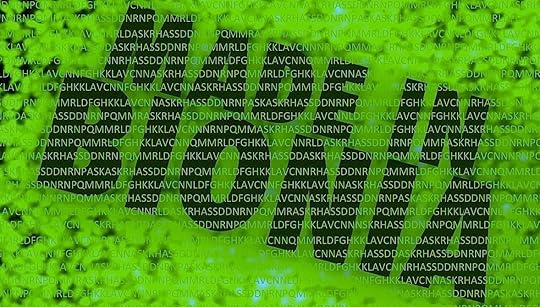Grigory Ryzhakov's Blog, page 7
October 18, 2013
From Businessman to Writer: Andrei Rubanov. Russian Prison
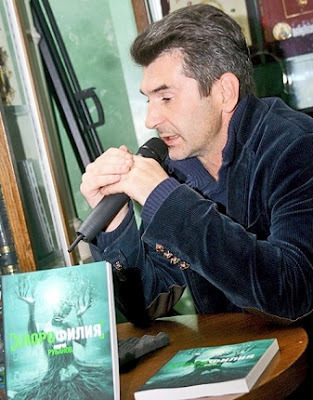
Andrei Rubanov presenting his book Chlorophilia
Many writers create amazing things they’ve never lived through just out their imagination. Still I find writers who experienced terrifying shortcomings of life are able to create truly vibrant prose. Andrei Rubanov is a modern Russian author who has both a very adventurous personal history and a vivid imagination.
I came across Rubanov’s work several years ago when I read his dystopian novel Chlorophilia, set in the XXII century Moscow. Almost entire Russia lives in Moscow, the rest of the territory is either abandoned or, like Siberia, leased to China. Basically, the Russian capital turned into a bio-metropolis. One day giant plant stalks, hundreds of meters tall, of an unknown origin, appeared from the ground and changed the Moscow landscape forever. The capital started growing vertically: the privileged occupied the upper levels enjoying the sunshine, while the poor lived on the lower levels, in the perpetual shade. People started using the mysterious plants as food and found it could be used as an energy-boosting drug.
The story focuses around a journalist called Saveliy who works for the most prestigious Moscow magazine. He is career-oriented, cynical, and deluded about his cloudless future. While observing people degrading in the lower levels, he doesn’t notice his own irreversible transformation. Only one thing can save him. Is this truth? Is this self-sacrifice?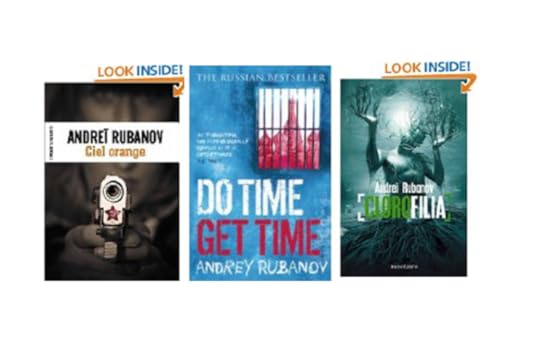
Chlorophilia is an inventive social satire applicable not just to Russia but any modern society. It’s quite a detour from Rubanov’s working genre of ultra-realism. His debut novel Do Time Get Time is his only work translated into English so far. The story, set in Russia in the 1990s, is autobiographical: a businessman gets imprisoned for financial fraud and comes out as a new person. True story. A bit of Russian Shantaram.
Rubanov is now a prolific author, publishing two novels a year, and he’s definitely one to watch.
October 16, 2013
What Is Threatening Coral Reefs?
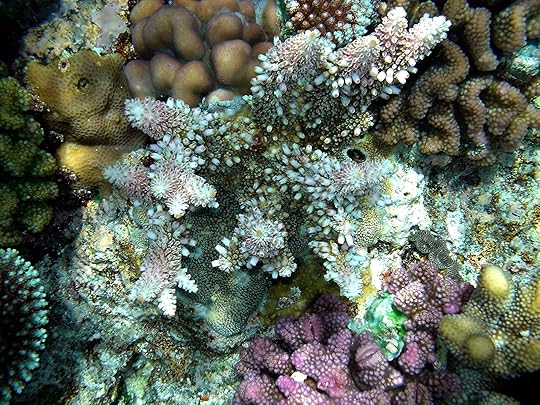
A coral reef, Papua New Guinea (photo by Brocken Inaglory, via Wikimedia Commons)
We often hear about the climate change and the never-ending discussion of it keeps making headlines in the media. There seem to be a consensus amongst climatologists – average atmospheric temperatures have been rising in the past several decades and the Arctic ice cap reducing. It’d be wrong to just call it global warming, as the local temperatures fluctuate so much that certain parts of the world could actually become cooler.
The central battle has been going on over one issue – to what extent climate change is caused by human activity. The problem is that our planet’s geochemical cycles are so complex, it’s hard to dissect the human factor and natural causes. Of course, the industrial emissions of carbon dioxide contribute to the greenhouse gas effect, and the CO2 levels have been on the rise ever since the records started.
One would say, okay, natural or human-driven, the changing climate will always shape our habitat, we just need to constantly adapt to that. The problem is that such changes normally occur over a long period of time , while the recent ones are fast.
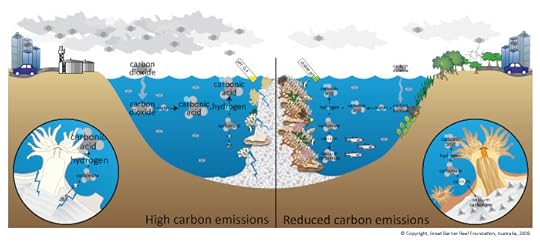
What is ocean acidification? Click on the picture to find out more
One of the most terrifying yet not much talked about consequences of the climate change is the decline of coral reefs. What is the connection between them and raising temperatures and CO2 levels?
Corals are colonial animals belonging to the group called Cnidaria and they are related to sea pens, jellyfish and sea anemones. Many reef-building species of corals use calcium carbonate, the limestone, to build their exoskeleton, enabling a small colony to grow into massive reefs. Corals are trees of the sea: they create habitats for other animals, including fish, and are indispensable for survival of many tropical marine ecosystems. With corals dead, the reef slowly becomes desolate.
Corals are also important regulators of the climate. They assimilate CO2 from seawater to build their exoskeleton, thus lowering the global greenhouse gas levels. Unfortunately, with CO2 levels raising too fast, there is an increasing acidification of the ocean – corals are less capable of taking CO2 at lower (acidic) pH and they suffer as a consequence.
Corals are symbiotic animals: the microscopical algae called zooxanthellae live in their cells, photosynthesise, and supply the coral with sugar and extra energy for growth. When corals are stressed as a result of pollution, increased water temperature or the pathogen attack, they lose their symbionts (and their colourful pigments), and eventually die. This process is called coral bleaching.
In the past few decades coral bleaching became a major problem. The coral reef decline is estimated to cause over 100 billion dollar loss for the world economy in the next 50 years. Add to this impacts on oceanic ecosystems and the global climate. The reefs are currently reducing by twenty percent each decade. It’s just unthinkable – the coral variety that took 600 million years to evolve could be wiped out in less than a century.
Is controlling the CO2 emissions sufficient to stop this disaster from developing? We don’t know.
The coral biology is not very well studied at molecular level. We don’t know much about the molecular triggers of the bleaching process. And that’s where, in my opinion, many research efforts should be directed.
Now in addition to acidification, other geochemical factors like warming water and deoxygenation devastate marine habitats, e.g. provoking massive expansion of jellyfish and toxic algal blooms. A brief report on that has been recently featured in New Scientist.
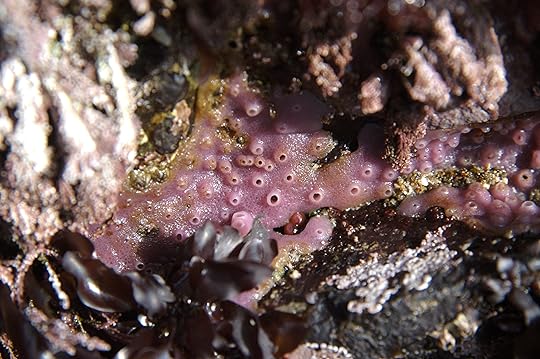
A sponge Haliclona permollis (photo by jkirkhart35 [CC-BY-2.0 (http://creativecommons.org/licenses/b...)], via Wikimedia Commons)
We more and more often see devastating reports in the media on the nature’s state, but sometimes we discover things that amaze us and give us hope in nature’s ability to self-regulate and sustain its habitats. Sponges, basal colonial animals, were found to be key organisms recycling organic matter and critical for the survival of coral reefs. A group of scientists used dye-labelled organic matter to track its accumulation in the coral reef ecosystem and found sponges to be primary consumers of this matter – sponges took in the labelled organic molecules dissolved in the seawater and then shed their dead cells into detritus, as an insoluble matter, that could be used as food by other reef’s organisms. Sponges turned out to recycle around ten times as much organic matter as bacteria did. Now the researchers are looking at ways of using sponges in coral reef preservation programmes.
Oceanology has always been in fashion. It is sad that the fashion is driven by the concern for the ocean’s future rather than wonder at planet’s biggest aquarium and its spectacular and mysterious life.
October 14, 2013
Thanks for Sharing. Addiction
If you have ever been addicted to anything – alcohol, smoking, internet, you name it, you might be interested in a new film called Thanks for Sharing.
The film is focused on sex addiction. In the beginning, it looks too funny until one of the characters, a hairdresser played by a pop star Pink, admits that it became so bad for her, she just wanted to kill herself.… Read the rest
October 11, 2013
Rush: Are Victory and Fame Worth Risking Your Life?
New Ron Howard’s film Rush is about the fast and dangerous world of Formula One. Set in the 1970s Rush focuses on the competition between two racers – a reckless, fun-loving British playboy, James Hunt, and a hard-working yet socially inept Austrian driver, Niki Lauda.… Read the rest
October 9, 2013
2013 Nobel Prize in Medicine: The Postal System of Our Cells
Most of our cells are just micrometers in size but they contain millions of molecules, some are small as glucose, others – colossal in size as large proteins and nucleic acids. Some of the molecules form rather static structures inside cells, being a part of cytoskeleton, and even those get reorganised all the time.… Read the rest
October 7, 2013
Modern Russian Writers: Ludmila Ulitskaya and Her Soviet Chronicles
The Soviet Union collapsed 22 years ago and we now have the whole generation of writers in Russia thinking about the recent Russian history and trying to understand and portray the Soviet phenomenon in their stories.
Ludmila Ulitskaya is probably the brightest representative of this generation.… Read the rest
October 5, 2013
Made in Bionia. The Planet in Danger
My next book, a sci-fi mystery called Made in Bionia, is at editing stage. I penned the first music theme to introduce you the starting event of the story – the ocean is poisoned and the sea life is dying as a result of a bioterrorist act.… Read the rest
October 2, 2013
Blue Jasmine. Dangers of Uncontrolled Emotion
Emotions make us human yet when uncontrolled they can ruin our life. Woody Allen’s new film Blue Jasmine is a convincing illustration of that.
Jasmine, breathtakingly performed by Cate Blanchett, used to live a problem-less superficial life, a fairy tale. She met her husband in her teens, he swept her off her feet and she dropped out of college.… Read the rest
September 30, 2013
Shame and Purity. Tatiana Moskvina
Very often incredibly talented people are modest and underappreciated. Three years ago I have read a novel that thrilled me to pieces, it was called Shame and Purity (Позор и Чистота). The author is Tatiana Moskvina, a media persona from St Peterburgh, she penned nearly twenty novels, non-fiction books and theatrical plays.… Read the rest
September 27, 2013
Loneliness and Solitude. Filling the Void Inside
This is a bit of a ‘free flow of thought’ post about a common fear of being lonely.
Homo sapiens is a social animal: the mankind has evolved in tribes and the solitary lifestyle is not natural for us. Yet the world is changing, urbanization and overpopulation create pressures for the traditional family model.… Read the rest

